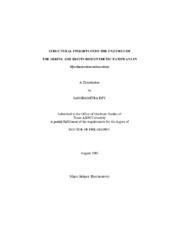| dc.description.abstract | Mycobacterium tuberculosis (Mtb) utilizes different metabolic pathways for its
survival during infection. Enzymes of these pathways are often targets for antibiotic
development. Genetic studies indicate the importance of the serine and biotin
biosynthetic pathways for Mtb survival. In this study, enzymes from these pathways
were characterized using X-ray crystallographic and biochemical studies.
D-3-phosphoglycerate dehydrogenase (PGDH) catalyzes the first step of
phosphorylated serine biosynthesis. In comparison to other forms of PGDH, the Mtb
enzyme has an insertion near its C-terminus. This insertion results in two different
conformations of the subunits in the tetramer, leading to two different environments for
cofactor binding. This intervening domain might provide a second binding site for
hydroxypyruvic acid phosphate (HPAP) that is responsible for substrate inhibition.
Analysis of the HPAP-bound Mtb PGDH active site reveals the residues (Arg52,
Arg131, and Arg233) involved in substrate interaction and provides insights into a
possible enzyme mechanism. Mtb PGDH is feedback inhibited by the end product Lserine.
Examination of the serine-bound PGDH structure elucidates the key players (Tyr461, Asp463, and Asn481) involved in this allosteric inhibition, as well as the
resultant conformational changes at the regulatory domain interface.
Preliminary biochemical studies of the first enzyme in Mtb biotin biosynthesis, 7-
keto-8-aminopelargonic acid (KAPA) synthase show that it exists as a dimer in solution
and has higher substrate affinity than the E. coli enzyme.
The second enzyme, 7, 8-diaminopelargonic acid synthase (DAPAS) uses Sadenosyl
methionine and KAPA as substrates in a bi-bi ping-pong mechanism. A
comparison of the substrate analog sinefungin-bound Mtb DAPAS structure with a
KAPA-bound DAPAS model provides a basis for the dual-substrate recognition. Tyr25
is a key player in the substrate specificity in DAPAS; this was confirmed by mutation
studies. In certain Bacillus species, a Phe replaces this Tyr. The KAPA-bound B. subtilis
DAPAS structure shows an alteration in the KAPA binding mode.
Substrate and product bound structures of the third enzyme, dethiobiotin
synthetase (DTBS) in Mtb reveal the important residues involved in its catalysis and
provide framework for a possible enzyme mechanism. Comparison to the DTBS
structures from E. coli and H. pylori reveals differences in local conformations. | en |


